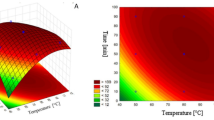Abstract
The anti-Escherichia coli activities of four extracts in leaves of Dracontomelon dao, a traditional folk herb in China were investigated and compared by microcalorimetry. The four extracts are PE fraction, CHCl3 fraction, EtOAc fraction, and n-BuOH fraction. The heat flow power–time (HFP–time) curves of E. coli growth in the presence of the four extracts were measured using an ampoule method. Then the nine thermal kinetic parameters were obtained from the curves. From the result of principal component analysis, it can be seen that parameters k 1, k 2, P 1, and Q p2 might be the main parameters in evaluating the anti-E. coli effects. In the presence of CHCl3 fraction, EtOAc fraction, and n-BuOH fraction, k 2, Q p2 of E. coli decreased with increasing concentrations of the extracts. The EtOAc fraction was observed to have the strongest anti-bacterial activity with half-inhibitory concentration IC50 of 98.5 μg mL−1. So, it can be concluded that EtOAc fraction can be further developed as anti-bacterial bioactive fraction of leaves of Dracontomelon dao.




Similar content being viewed by others
References
Khan MR, Omoloso AD. Antibacterial and antifungal activities of Dracontomelon dao. Fitoterapia. 2002;73:327–30.
Su XF, Nong WT. Study on the antimicrobial effect of the extracts of leaves of Dracontomelon dao. China Dispens. 2010;21:2115–7.
Su XF, Liang ZY, Nong KL. Study on chemical constituents of volatile oil of leaves of Dracontomelon dao. Chin Pat Drug. 2008;30:1549–50.
Wadsö I. Isothermal microcalorimety: current problems and prospects. J Therm Anal Calorim. 2001;64:75–84.
Kong WJ, Zhao YL, Shan LM, **ao XH, Guo WY. Investigation on the spectrum–effect relationships of EtOAc extract from Radix Isatidis based on HPLC fingerprints and microcalorimetry. J Chromatogr B. 2008;871:109–14.
Li X, Liu Y, Jun W, Liang HG, Qu SS. Microcalorimetric study of Staphylococcus aureus growth affected by selenium compounds. Thermochim Acta. 2002;387:57–61.
Yao J, Tian L, Wang F, Chen HL, Xu CQ, Su CL, Cai MF, Maskow T, Zaray G, Wang YX. Microcalorimetric study on effect of chromium (III) and chromium (VI) species on the growth of Escherichia coli. Chin J Chem. 2008;26:101–6.
McGulnness MS, Barisas BG. Acute toxicity measurements on aquatic pollutants using microcalorimetry on tissue-cultured cells. Environ Sci Technol. 1991;25:921.
Kong WJ, Zhao YL, Shan LM, **ao XH, Guo WY. Thermochemical studies on the quantity–antibacterial effect relationship of four organic acids from Radix Isatidis on Escherichia coli growth. Biol Pharm Bull. 2008;31:1301–5.
Furustrand Tafin U, Clauss M, Hauser PM, Bille J, Meis JF, Trampuz A. Isothermal microcalorimetry: a novel method for real-time determination of antifungal susceptibility of Aspergillus species. Clin Microbiol Infect. 2012;18:E241–5.
**e CL, Tang HK, Song ZH, Qu SS, Liao YT, Liu HS. Microcalorimetric study of bacterial growth. Thermochim Acta. 1988;123:33–41.
Chen J, Wang F, Liu J, Lee FS, Wang X, Yang H. Analysis of alkaloids in Coptis chinensis Franch by accelerated solvent extraction combined with ultra performance liquid chromatographic analysis with photodiode array and tandem mass spectrometry detections. Anal Chim Acta. 2008;613:184–95.
Chen Y, Zhu SB, **e MY, Nie SP, Liu W, Li C, Gong XF, Wang YX. Quality control and original discrimination of Ganoderma lucidum based on high-performance liquid chromatographic fingerprints and combined chemometrics methods. Anal Chim Acta. 2008;623:146–56.
Yi LZ, Yuan DL, Liang YZ, **e PS, Zhao Y. Quality control and discrimination of pericarpium citri reticulatae and pericarpium citri reticulatae viride based on high-performance liquid chromatographic fingerprints and multivariate statistical analysis. Anal Chim Acta. 2007;588:207–15.
Yi ZB, Yan Y, Liang YZ, Bao Z. Evaluation of the antimicrobial mode of berberine by LC/ESI-MS combined with principal component analysis. J Pharm Biomed Anal. 2007;44:301–4.
Kong WJ, ** C, **ao XH, Zhao YL, Li ZL, Zhang P, Liu W, Li XF. Comparative study of effects of two bile acid derivatives on Staphylococcus aureus by multiple analytical methods. J Hazard Mater. 2010;179:742–7.
Kong WJ, Wang JB, **ng XY, ** C, **ao XH, Zhao YL, Zhang P, Zang QC, Li ZL. Screening for novel antibacterial agents based on the activities of compounds on metabolism of Escherichia coli: a microcalorimetric study. J Hazard Mater. 2011;185:346–52.
Kong WJ, Zhao YL, **ao XH, ** C, Liu Y, Li ZL. Comparison of anti-bacterial activity of four kinds of alkaloids in Rhizoma Coptidis based on microcalorimetry. Chin J Chem. 2009;27:1186–90.
Kong WJ, **ao XH, **ao XH, Zhao YL, Wei JH, Wang JB, Yang RC, Yang MH. Effect of berberine on Escherichia coli, Bacillus subtilis, and their mixtures as determined by isothermal microcalorimetry. Appl Microbiol Biotechnol. 2012. doi:10.1007/s00253-012-4302-y.
Acknowledgements
The authors are grateful for the support from the National Natural Science Foundation of China (81173571; 81303120); the “twelfth Five-Year Plan” Foundation of China people’s Liberation Army (No: CWS11C164) and the major projects of the National Science and Technology (2012ZX10005010-002-002).
Author information
Authors and Affiliations
Corresponding author
Rights and permissions
About this article
Cite this article
Liu, S., Zhao, Y., Zeng, N. et al. Anti-bacterial effect of four extracts from leaves of Dracontomelon dao on Escherichia coli growth using microcalorimetry coupled with principal component analysis. J Therm Anal Calorim 116, 491–497 (2014). https://doi.org/10.1007/s10973-013-3516-2
Received:
Accepted:
Published:
Issue Date:
DOI: https://doi.org/10.1007/s10973-013-3516-2




